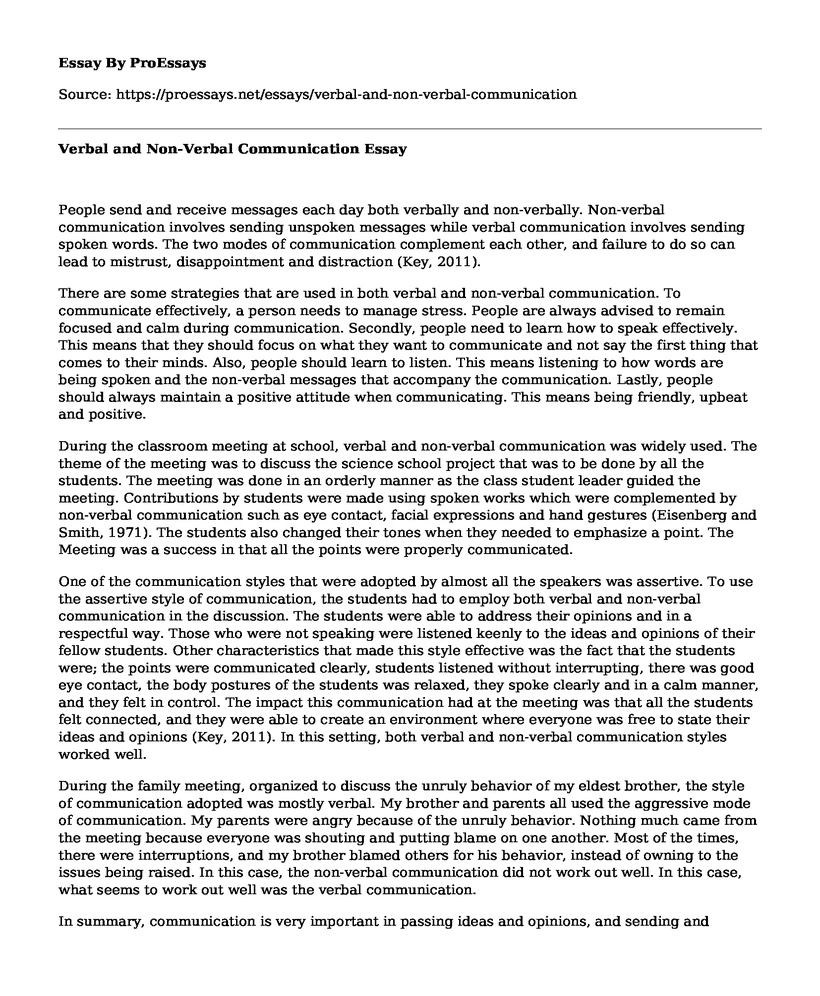People send and receive messages each day both verbally and non-verbally. Non-verbal communication involves sending unspoken messages while verbal communication involves sending spoken words. The two modes of communication complement each other, and failure to do so can lead to mistrust, disappointment and distraction (Key, 2011).
There are some strategies that are used in both verbal and non-verbal communication. To communicate effectively, a person needs to manage stress. People are always advised to remain focused and calm during communication. Secondly, people need to learn how to speak effectively. This means that they should focus on what they want to communicate and not say the first thing that comes to their minds. Also, people should learn to listen. This means listening to how words are being spoken and the non-verbal messages that accompany the communication. Lastly, people should always maintain a positive attitude when communicating. This means being friendly, upbeat and positive.
During the classroom meeting at school, verbal and non-verbal communication was widely used. The theme of the meeting was to discuss the science school project that was to be done by all the students. The meeting was done in an orderly manner as the class student leader guided the meeting. Contributions by students were made using spoken works which were complemented by non-verbal communication such as eye contact, facial expressions and hand gestures (Eisenberg and Smith, 1971). The students also changed their tones when they needed to emphasize a point. The Meeting was a success in that all the points were properly communicated.
One of the communication styles that were adopted by almost all the speakers was assertive. To use the assertive style of communication, the students had to employ both verbal and non-verbal communication in the discussion. The students were able to address their opinions and in a respectful way. Those who were not speaking were listened keenly to the ideas and opinions of their fellow students. Other characteristics that made this style effective was the fact that the students were; the points were communicated clearly, students listened without interrupting, there was good eye contact, the body postures of the students was relaxed, they spoke clearly and in a calm manner, and they felt in control. The impact this communication had at the meeting was that all the students felt connected, and they were able to create an environment where everyone was free to state their ideas and opinions (Key, 2011). In this setting, both verbal and non-verbal communication styles worked well.
During the family meeting, organized to discuss the unruly behavior of my eldest brother, the style of communication adopted was mostly verbal. My brother and parents all used the aggressive mode of communication. My parents were angry because of the unruly behavior. Nothing much came from the meeting because everyone was shouting and putting blame on one another. Most of the times, there were interruptions, and my brother blamed others for his behavior, instead of owning to the issues being raised. In this case, the non-verbal communication did not work out well. In this case, what seems to work out well was the verbal communication.
In summary, communication is very important in passing ideas and opinions, and sending and receiving of information. However, for a communication style to be effective the right mode of communication has to be adopted for different communication situations. There are situations that require the use of both verbal and non-verbal communication, but also, that will require the use of one style. Both styles do not fit well in some situations, and therefore, a person ought to be careful when selecting the mode of communication to use.
References
Eisenberg, A. M., & Smith, R. R. (1971). Non-verbal communication. Indianapolis: Bobbs-Merrill.
Key, M. R. (2011). The Relationship of Verbal and Nonverbal Communication. De Gruyter Mouton.
Cite this page
Verbal and Non-Verbal Communication. (2021, Mar 12). Retrieved from https://proessays.net/essays/verbal-and-non-verbal-communication
If you are the original author of this essay and no longer wish to have it published on the ProEssays website, please click below to request its removal:
- The Apple Inc.'s Ethical Dilemma
- Essay on Impact of Education on Success
- The Wealthy Should Not Be Praised for Helping the Less Fortunate
- Paper Example on Achieve Success With Learning Agility & Strategy
- Paper Example on 30-Day Challenge: Get 6 Hours of Sleep & Improve Lifestyle
- Essay on Activists Secure Social Welfare for Vulnerable Lives via US Govt. Programs
- Parent-Child Relationship: Impact on Life Even in Adulthood - Essay Sample







